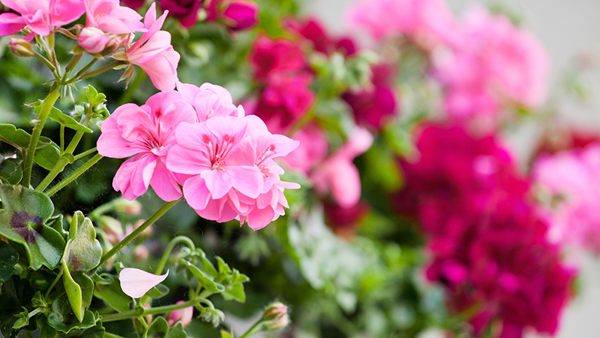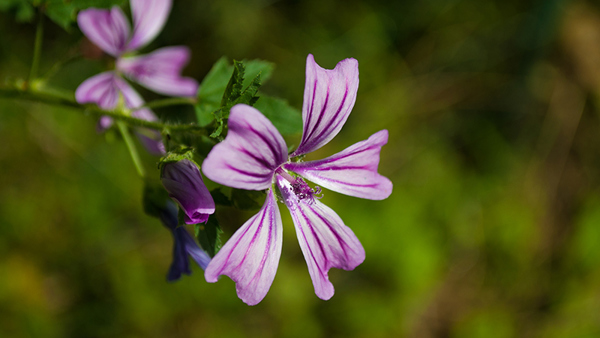Yates Account
Join now
Create a Yates account today!
Sign up to join the Yates Garden Club for monthly e-mails packed with seasonal inspiration, tips for success & exclusive promotions.
Plus if you’re a Garden Club member you can take part in the Yates Growing Community - a blog to share successes, get advice & win prizes in fun challenges along the way!

Forgot password
Enter the email address associated with your account, and we'll email you a new password.

Pelargoniums (Pelargonium spp.) or geraniums as they are commonly known and still referred to, are great perennial plants for the easy care gardener. They require little attention once established and thrive in hot, dry conditions. There are a variety of colours and leaf forms available, all suitable for pots, hanging baskets or garden beds.
How to grow geraniums in a garden
- Choose a spot in the garden that receives full sun. Enrich the well-drained soil with Yates Thrive Natural Blood & Bone with Seaweed. If the soil is clay-based, add gypsum and fork in well.
- Dig the planting hole twice as wide and to the same depth as the root-ball. Remove the shrub from the container, gently tease the roots.
- Position in hole and backfill with soil, gently firming down. Form a raised or doughnut-shaped ring of soil around the outer edge of the plant's root zone. This helps keep water where it's needed. Always water in well after planting to settle the soil around the roots.
- Mulch around the base with organic mulch like bark chips, woodchip or pea straw, keeping it away from the trunk.
- Water deeply, one to two times a week, depending on weather conditions.
- Feed during the growing and flowering season with Yates Thrive Rose & Flower Granular Plant Food. TIP: For an added boost apply Yates Thrive Roses & Flowers Liquid Plant Food.


How to grow geraniums in a pot
- Choose a pot at least 600mm wide. Position in full sun and fill with quality potting mix, such as Yates Premium Potting Mix.
- Remove the shrub from the container, gently tease the roots.
- Position in hole and backfill with potting mix, gently firming down. Water in well.
- Mulch around the base with organic mulch like bark chips, woodchip or pea straw, keeping it away from the trunk.
- Once planted, keep the plant well watered but don’t let the water sit in a saucer at the base of the pot.
- Feed regularly with Yates Thrive Roses & Flowers Liquid Plant Food. TIP: For an added boost, apply Yates Thrive Natural Fish & Seaweed+ Plant Food Concentrate.
Growing tips
- Geraniums don’t like wet feet. Avoid having them in overly damp soils or conditions. Best results are achieved if you allow the soil to dry out in between watering.
- Avoid overhead watering. This will reduce the risk of fungal diseases.
- In cool temperate areas, they can handle light frosts. Lightly prune after each flush of flowers to encourage more blooms.
- Harder prunes (one to two thirds of the plant) can be carried out in autumn when flowering has finished.
- Geraniums can be easily propagated from cuttings.
- Ivy leaf pelargoniums are known to keep cats away from gardens due to the strong oil content in the leaves.
- There are many different species of Geraniums/Pelargoniums. Some of these include:
Standard Geranium
The most common variety on the market. It has large green furry leaves with lovely flushes of flowers from spring to late summer, but in some areas, they can flower all year round.
Ivy Leaf Pelargonium
Trailing growing pelargonium, with highly scented, ivy shaped leaves with small flowers. Great for pots and to be used as a ground cover in hot dry areas.
Scented Geraniums
Scented Geraniums are grown mainly for their leaves more than for their flowers. They differ from the standard forms of geraniums as their leaves are slightly furled at the edge, giving them a ruffled effect. Crush the leaves to release the oils and create a lovely scented area in the garden. There are many different scents and varieties available, including Rose (P. graveolens), Apple (P. ordoratissimum), Peppermint (P. tomentosum) and even Lemon (P. citronella). Some are even edible, but check the labels prior to consumption.
Zonal Pelargonium (P. hororum)
Not only does this variety have lovely flowers, it has unique leaf form. These differ from the other varieties in their zones or outlines in the leaves. These zones can be simple (just two colour forms) or complex (three or more colour forms) and make a stand out feature plant for the garden or pots.
Orange trumpet vine, with its brilliant cascading masses of orange tubular flowers, is one of the most spectacular winter flowering climbers.
Spring Stars
Spring Stars are a versatile addition to any garden with delightful lavender-blue, star shaped blooms.
Flax
Flaxes (Phormium spp.) are highly versatile plants which don't mind swampy or dry conditions. Great for large pots or planted en-masse in garden beds.
Proteas
Not just any old blossom, protea flowers are blooms with attitude. If you can give them full sun and reasonable drainage, proteas will love you.
Recommended products
Yates Thrive Natural Blood & Bone with Seaweed
A certified organic garden input boosted with NZ Seaweed to gently nourish plants, enrich the soil and encourage a strong healthy root system.
Yates Thrive Rose & Flower Granular Plant Food
Specially formulated to grow all types of flowers. With high potassium for large & abundant flowers, added calcium & iron for stronger flowers.
Yates Premium Potting Mix
A premium potting mix, ideal for all potted plants and shrubs, including ornamentals, fruit trees, vegies and herbs.
Yates Thrive Roses & Flowers Liquid Plant Food
Provides your flowers & roses with the balanced nutrients they require for healthy growth and flower production.
















Share
Share this article on social media